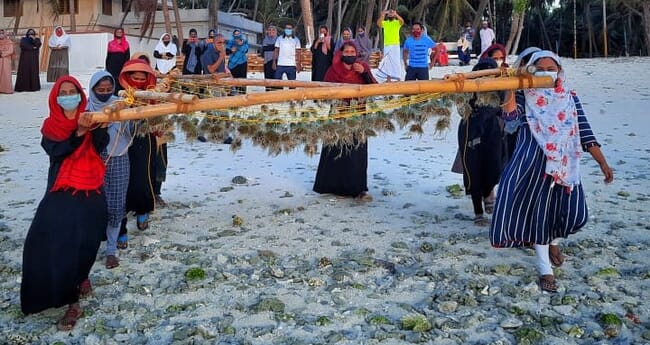
© CMFRI
Stressing the need for upscaling seaweed farming, Dr A Gopalakrishnan, director of ICAR-CMFRI, said that the institute has done georeferencing of 342 additional suitable farming sites over 24,167 ha with a production potential of 9.7 million tonnes (wet weight) per year.
He was speaking at a National Campaign on non-conventional aquaculture systems organised by the CMFRI as part of the Azadi Ka Amirt Mahotsav.
“While referring to the global production that is 35 million tonnes worth 16.5 billion dollars in 2022 so far, India is far behind in terms of seaweed production,” he added.
Citing that the country is taking all measures to boost its production, Dr Gopalakrishnan pointed out that the government earmarked Rs. 640 crore exclusively to promote seaweed culture with a targeted production of more than 11.2 lakh (1.12 million) tonnes by 2025, in the Pradhan Mantri Matsya Sampada Yojana (PMMSY).
“The CMFRI has successfully standardised the practice of integrated multi-trophic aquaculture (IMTA) which enables cage farming or bivalve farming along with seaweed farming in coastal waters,” he said, adding that this technology would help popularise and boost seaweed farming across the coastal states.
Referring to its environmental benefits, he said that seaweed farming can earn carbon credits in many ways and cited the example of replacing fodder with the value-added products of the plants to reduce methane emission from cattle to great extent.
Abhiram Seth, managing director of AquAagri Processing, said that deep sea areas should be identified to increase the production. Emphasising the need for large quantity of planting material for the large-scale expansion of seaweed farming, Seth expressed the interest in collaborating with ICAR-CMFRI for commercial-level micro-propagation based seaweed seed production.
The meet also highlighted the importance of bivalve farming, another non-conventional aquaculture practice. According to the CMFRI estimates, India’s bivalve production in 2021 was 98,000 tonnes.
“CMFRI’s recent success includes commercial production of seeds of green and brown mussels and cultch-less spat production of edible oysters with a high survival rate at Vizhinjam. More than 6,000 women self-help groups are engaging with bivalve farming under the guidance of the CMFRI,” he said.




